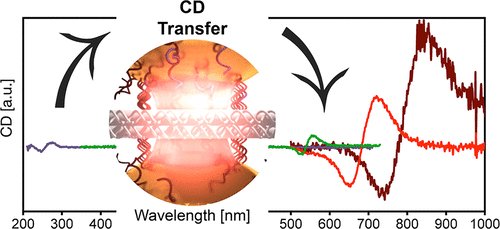Our official English website, www.x-mol.net, welcomes your
feedback! (Note: you will need to create a separate account there.)
Circular Dichroism of Chiral Molecules in DNA-Assembled Plasmonic Hotspots
ACS Nano ( IF 15.8 ) Pub Date : 2018-09-06 00:00:00 , DOI: 10.1021/acsnano.8b03146 Luisa M. Kneer 1 , Eva-Maria Roller 1 , Lucas V. Besteiro 2 , Robert Schreiber 1 , Alexander O. Govorov 2, 3 , Tim Liedl 1
ACS Nano ( IF 15.8 ) Pub Date : 2018-09-06 00:00:00 , DOI: 10.1021/acsnano.8b03146 Luisa M. Kneer 1 , Eva-Maria Roller 1 , Lucas V. Besteiro 2 , Robert Schreiber 1 , Alexander O. Govorov 2, 3 , Tim Liedl 1
Affiliation

|
The chiral state of a molecule plays a crucial role in molecular recognition and biochemical reactions. Because of this and owing to the fact that most modern drugs are chiral, the sensitive and reliable detection of the chirality of molecules is of great interest to drug development. The majority of naturally occurring biomolecules exhibit circular dichroism (CD) in the UV range. Theoretical studies and several experiments have demonstrated that this UV-CD can be transferred into the plasmonic frequency domain when metal surfaces and chiral biomolecules are in close proximity. Here, we demonstrate that the CD transfer effect can be drastically enhanced by placing chiral molecules, here double-stranded DNA, inside a plasmonic hotspot. By using different particle types (gold, silver, spheres, and rods) and by exploiting the versatility of DNA origami, we were able to systematically study the impact of varying particle distances on the CD transfer efficiency and to demonstrate CD transfer over the whole optical spectrum down to the near-infrared. For this purpose, nanorods were also placed upright on DNA origami sheets, forming strong optical antennas. Theoretical models, demonstrating the intricate relationships between molecular chirality and achiral electric fields, support our experimental findings. From both experimental measurements and theoretical considerations, we conclude that the transferred CD is most intensive for systems with strong plasmonic hotspots, as we find them in relatively small gaps (5–12 nm) between spherical nanoparticles and preferably between the tips of nanorods.
中文翻译:

DNA组装的等离子热点中的手性分子的圆二色性。
分子的手性态在分子识别和生化反应中起着至关重要的作用。因此,由于大多数现代药物都是手性的,因此分子的手性的灵敏而可靠的检测对于药物开发非常重要。大多数天然存在的生物分子在紫外线范围内表现出圆二色性(CD)。理论研究和一些实验表明,当金属表面和手性生物分子非常接近时,该UV-CD可以转移到等离子体频率域中。在这里,我们证明通过将手性分子(此处为双链DNA)放置在等离子体热点内可以大大增强CD的转移效果。通过使用不同的粒子类型(金,银,球,和棒),并利用DNA折纸的多功能性,我们能够系统地研究不同距离的粒子对CD传输效率的影响,并证明了在整个光谱范围内(直至近红外)的CD传输。为此,纳米棒也直立放置在DNA折纸上,形成坚固的光学天线。理论模型证明了分子手性与非手性电场之间的复杂关系,支持了我们的实验结果。从实验测量和理论考虑,我们得出结论,对于具有强等离子热点的系统,转移的CD最密集,因为我们发现它们位于球形纳米粒子之间,最好是纳米棒尖端之间相对较小的间隙(5–12 nm)中。我们能够系统地研究不同距离的粒子对CD传输效率的影响,并证明了CD在整个光谱范围内(直至近红外)的传输。为此,纳米棒也直立放置在DNA折纸上,形成坚固的光学天线。理论模型证明了分子手性与非手性电场之间的复杂关系,支持了我们的实验结果。从实验测量和理论考虑,我们得出结论,对于具有强等离子热点的系统,转移的CD最密集,因为我们发现它们位于球形纳米粒子之间,最好是纳米棒尖端之间相对较小的间隙(5–12 nm)中。我们能够系统地研究不同距离的粒子对CD传输效率的影响,并证明了CD在整个光谱范围内(直至近红外)的传输。为此,纳米棒也直立放置在DNA折纸上,形成坚固的光学天线。理论模型证明了分子手性与非手性电场之间的复杂关系,支持了我们的实验结果。从实验测量和理论考虑,我们得出结论,对于具有强等离子热点的系统,转移的CD最密集,因为我们发现它们位于球形纳米粒子之间,最好是纳米棒尖端之间相对较小的间隙(5–12 nm)中。
更新日期:2018-09-06
中文翻译:

DNA组装的等离子热点中的手性分子的圆二色性。
分子的手性态在分子识别和生化反应中起着至关重要的作用。因此,由于大多数现代药物都是手性的,因此分子的手性的灵敏而可靠的检测对于药物开发非常重要。大多数天然存在的生物分子在紫外线范围内表现出圆二色性(CD)。理论研究和一些实验表明,当金属表面和手性生物分子非常接近时,该UV-CD可以转移到等离子体频率域中。在这里,我们证明通过将手性分子(此处为双链DNA)放置在等离子体热点内可以大大增强CD的转移效果。通过使用不同的粒子类型(金,银,球,和棒),并利用DNA折纸的多功能性,我们能够系统地研究不同距离的粒子对CD传输效率的影响,并证明了在整个光谱范围内(直至近红外)的CD传输。为此,纳米棒也直立放置在DNA折纸上,形成坚固的光学天线。理论模型证明了分子手性与非手性电场之间的复杂关系,支持了我们的实验结果。从实验测量和理论考虑,我们得出结论,对于具有强等离子热点的系统,转移的CD最密集,因为我们发现它们位于球形纳米粒子之间,最好是纳米棒尖端之间相对较小的间隙(5–12 nm)中。我们能够系统地研究不同距离的粒子对CD传输效率的影响,并证明了CD在整个光谱范围内(直至近红外)的传输。为此,纳米棒也直立放置在DNA折纸上,形成坚固的光学天线。理论模型证明了分子手性与非手性电场之间的复杂关系,支持了我们的实验结果。从实验测量和理论考虑,我们得出结论,对于具有强等离子热点的系统,转移的CD最密集,因为我们发现它们位于球形纳米粒子之间,最好是纳米棒尖端之间相对较小的间隙(5–12 nm)中。我们能够系统地研究不同距离的粒子对CD传输效率的影响,并证明了CD在整个光谱范围内(直至近红外)的传输。为此,纳米棒也直立放置在DNA折纸上,形成坚固的光学天线。理论模型证明了分子手性与非手性电场之间的复杂关系,支持了我们的实验结果。从实验测量和理论考虑,我们得出结论,对于具有强等离子热点的系统,转移的CD最密集,因为我们发现它们位于球形纳米粒子之间,最好是纳米棒尖端之间相对较小的间隙(5–12 nm)中。











































 京公网安备 11010802027423号
京公网安备 11010802027423号